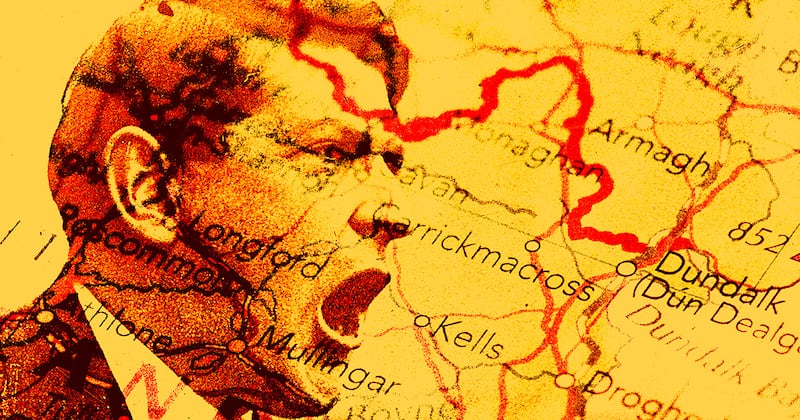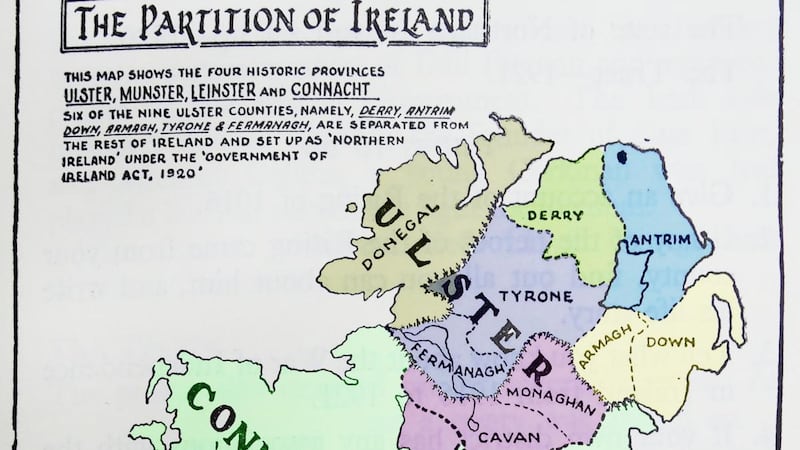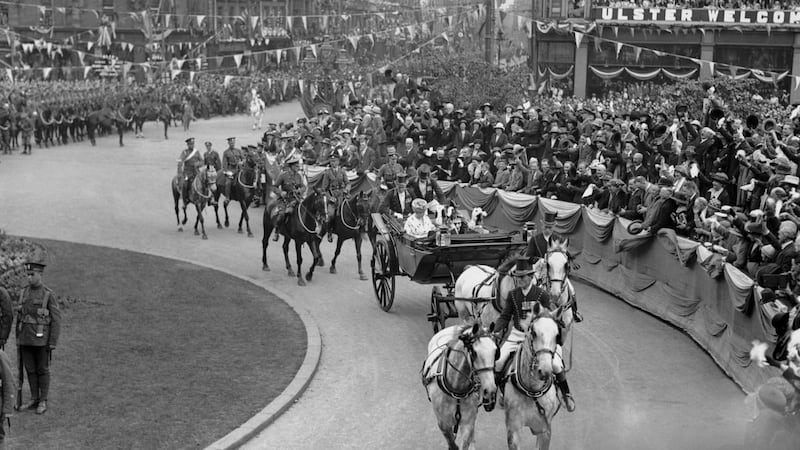This is the first of a series of articles The Irish Times will publish in the coming weeks, to mark the centenary of partition in May 2021
Partition is inherently a divisive action – it originates in division and produces divided understandings. The partition of Ireland has been no exception.
The Border was created a hundred years ago by an Act of the UK parliament, but how did such an Act emerge? Did it show the bankruptcy of British statesmanship, or something even worse?

The Government of Ireland Act was designed to accommodate Ulster Unionists’ refusal to accept the rule of a Dublin parliament under Home Rule. To Irish nationalists, the motive for this refusal was their arrogant determination to maintain Protestant ascendancy. For unionists it was the fear that Home Rule would be “Rome Rule”, creating a priest-ridden country where Protestants would be dispossessed and progress would go into reverse. This fear seemed to many absurd or even discreditable, but that did not make it unreal.
Ulster unionism has seldom enjoyed a good press. Its beating heart, Orangeism, has incurred consistent dislike, indeed disdain. One thoughtful observer of the movement in 1914 noted that few such powerful communal ideas had found quite so few “reputable defenders”.
For nationalists, it was a prime example of both bigotry and British manipulation – Orange mobs never moved without orders, the nationalist leader Tim Healy stated as simple fact, and the orders came ultimately from Britain. This denial of authenticity or spontaneity has persisted.
In Britain itself, a country which “Ulstermen” found difficult to trust, Ulster’s loyalty played well in Britain when Home Rule – by no means popular – first appeared. Even so, the British attitude was often ambivalent. The great historian Lord Macaulay, who was crucial to establishing Ulster’s claim to a central role in the development of British democracy, also lamented the “wrath and defiance” which disfigured Ulster loyalism.
Loyalism’s unattractiveness rested on its extreme ideology, in which loyalty to the crown was combined with extreme anti-Catholicism of a kind which had gone out of fashion in Britain. But the strength of the wider argument against Home Rule did not come from such extreme ideas.
As soon as the Repeal movement was launched in the 1830s, Macaulay pointed out that the arguments Daniel O’Connell advanced for a government in Dublin would equally justify another government in the north.
Political spectrum
WE Gladstone’s sudden acceptance of the Home Rule case in 1885 came as a shock to many, right across the political spectrum. Indeed it split his own Liberal party, one of the two great governing parties of the 19th century. The radical icon John Bright declared it “offensive to . . . the loyal and Protestant people” of Ulster; he refused “to exclude them from the protection of the Imperial Parliament”. Joseph Chamberlain, resigning over the issue, demanded a separate Ulster parliament.
Gladstone refused to give ground on this, ensuring the defeat of his two Home Rule Bills and a long period in opposition for the Liberals. When they picked up the cause again in 1910, his successor, HH Asquith, remained committed to Irish unity, but the huge political storm provoked by his Home Rule Bill wore away at this commitment.
Unionist arguments had been honed over a quarter of a century, and Ulster loyalist hostility to Catholic power had been refuelled. The nature of Irish nationalism itself was shifting in a revolutionary way, creating an Irish identity whose Gaelic and Catholic lineaments made unionists feel less “Irish” than they had a century before.
The “Ulster crisis” was supercharged by belief in a “corrupt bargain” between Liberals and the Irish party; the opposition denounced the government as “a revolutionary committee which has seized on despotic power by fraud” and insisted that such major constitutional change needed an “English majority”.
Many, including the high priest of the constitution, AV Dicey, called for a national referendum. The likelihood that this would have produced a decisive majority against Home Rule racked up the pressure on Asquith’s cabinet.
The chief secretary rashly called for proof that Ulster wanted “to cut herself off from the rest of Ireland”. The apparent implication was that if such proof appeared, policy might change. This was almost an invitation to Ulster militants to step up the threat of organised mass action, signalled by the big rally at Craigavon in September 1911, and to British unionists – notably Lord Milner – to back them with a similar organisation on the mainland.
Military discipline
In Ulster, a citizen militia with six-figure membership was formed. In Britain, outraged Tories began planning extreme measures, even opposing the Army Annual Act, on which military discipline – and the army’s obedience to the elected government – rested.
British public dislike of Home Rule has been underplayed in many accounts of the crisis. Machinations within the army generated a perilous politicisation, manifested in the “Curragh mutiny” of 1914, which ended with the army effectively assuming the right to decide which laws it would enforce. The government made light of it, but it was truly serious.

Talk of civil war reached a pitch unheard since the 17th century, and indeed it is hard to see how otherwise the political deadlock could have been resolved. All this highly unEnglish behaviour indicated how deep the crisis went.
The question has always been, should the government have stood firm in spite of this? Though some ministers – notably the belligerent Winston Churchill – might declaim "let us go forward together and put these grave matters to the proof", his ministerial colleagues had less appetite for such a showdown. Did they accept Ulster's claim too easily?
As soon as the Bill was launched, an amendment was proposed – by a Liberal backbencher – to exclude four Ulster counties from Home Rule. The government resisted this, but chief secretary Augustine Birrell began to talk of holding a “referendum” to “settle the fate” of the northeast.
He believed optimistically that such a poll would leave only two counties, Antrim and Down, standing out against Home Rule. But though he publicly subscribed to the nationalist view that the threat of Ulster resistance was mere bluff, in private he accepted that – unlike the “absurd” former Ulster cries of “wolf” – this time “her yells are genuine”.
The crucial convert to "exclusion" was the chancellor of the exchequer, David Lloyd George, who decided that Home Rule "could not be imposed on Ulster by force" – "if possible the Protestant counties should be exempted".
What were his motives? Like many nonconformist Liberals, he had an anti-Catholic streak, but he was primarily a pragmatic problem-solver. Under his influence the principle that “Ulster” could not be coerced grew into a governing tenet.
Idea of partition
At the time of the exclusion amendment, most unionists rejected any idea of partition: they saw Ulster’s mobilisation as a bulwark against Home Rule in its entirety. Like the nationalists, they assumed that Ireland was a single political entity. This would change over time.
It took five years after 1912 for partition to become official government policy. In 1914, Asquith offered temporary exclusion, which was rejected. Then World War broke out, temporarily lifting him out of the mire, as he recognised. Though he pushed the Home Rule Act through, he suspended it for the duration of hostilities and undertook that after the war it would be amended to give some (unspecified) special status to some part of Ulster.
Partition remained embryonic until 1916. The Rising dramatically accelerated the partition process, by convincing Asquith that the Irish difficulty had to be fixed, primarily to keep the Dominions and the USA on side. Lloyd George, tasked with “settling Ireland”, immediately put together a new Home Rule proposal giving six Ulster counties the right to opt out – permanently. This project was torpedoed not by the nationalists but by the southern unionists, still clinging to Irish unity.
But this was a brief delay; partition was now taking definite form. When, with Lloyd George now prime minister, yet another Home Rule Bill was drafted in 1917 – again with an eye to American opinion – it finally dumped any lingering unionist idea that the excluded area would remain under the UK parliament, and introduced two equal Irish parliaments.
So when the war at last came to an end, the Irish political situation had been drastically recast. Not only was the constitutional nationalist party wiped out by the new quasi-republican Sinn Féin, but “Ulster” was to have Home Rule alongside “southern” Ireland.
The final Home Rule Bill, which became the 1920 Government of Ireland Act, never generated much enthusiasm – then or later. It was drafted by a foursquare unionist, Walter Long, who might in other circumstances have become a leader of the Tory diehards. “Why touch HR now?”, he asked when Lloyd George tasked him with preparing the Bill.
Federal UK
But Long had an idea which he believed could hold unionists and Home Rulers together – federalism. Most unionists still wanted to keep Ulster an integral part of the Westminster-ruled state, but Long decided it must have Home Rule like the rest of Ireland. That would “get rid of the tap root of the Irish difficulty” by completely removing British rule.
There would have to be two Irish parliaments, but they would be linked by a Council of Ireland, which would provide a mechanism for progressive movement towards unity. The whole arrangement would eventually become part of a federal UK system.
Long said that Home Rule for Ulster would “enormously minimise the partition issue”, and the government was as conscious as its Liberal predecessors of the need to demonstrate that Irish unity was the eventual goal.
All this has usually been seen by Irish nationalists as mere deception, but Long believed in it. He was surprised to find that the Ulster Unionist leader, James Craig, suddenly embraced Home Rule with enthusiasm. This would have big implications for the future Irish Border line.
Craig’s overriding aim was to secure the integrity of the six-county unit, under slogans like “what we have, we hold” and “not an inch”. It had been a painful task for Edward Carson to persuade the Ulster Unionist Council to accept the Lloyd George project in 1916, abandoning three of the nine Ulster counties bound by the 1912 Covenant. He told them that if they would not have “six counties clean and free”, British opinion would not support them.
After this "sacrifice", Ulster unionists dug in. Long's Government of Ireland Bill originally envisaged a nine-county Northern Ireland, and the area was reduced to six only just before the Bill's first reading. The decisive argument was Arthur Balfour's warning against creating a Hibernia irredenta, and both he and Lloyd George assumed that some kind of border adjustment – a plebiscite on the Versailles Treaty model – would be needed to reach what the prime minister called "an area which is as homogeneous as it is possible to achieve".
The idea of adjusting the six-county boundary – a border which many Ulster unionists called “ridiculous” – persisted after the establishment of the Northern Ireland state in 1921. The borderline was certainly not fixed by the Government of Ireland Act.
Territorial transfers
Lloyd George's last decisive contribution to "settling Ireland" was pushing the Anglo-Irish Treaty through by the device of a boundary commission to revise the frontier. Arthur Griffith and Michael Collins certainly expected substantial territorial transfers, and Lloyd George may not have been completely honest in encouraging them to think this.
Still, if the clause had been invoked immediately after the treaty was ratified, as Griffith had wanted, it might well have happened. But the outbreak of civil war halted any idea of revision, and by the time the war ended both Griffith and Collins were dead and Lloyd George had been overthrown.

Cosgrave eventually invoked the clause in July 1923, appointing Eoin MacNeill as the Free State’s boundary commissioner. The British attitude had become clear in the parliamentary debate on the treaty, when Churchill strove to persuade sceptical MPs that any revisions would be insignificant.
Key influencers such as Lionel Curtis and Tom Jones, the cabinet secretary, wanted the whole idea of a commission replaced by an inter-governmental settlement. Northern Ireland’s inevitable refusal to appoint a commissioner caused a further delay, and a chairman was not nominated until June 1924. The lapse of time meant that “facts on the ground” had changed, often to nationalist disadvantage.
Irish nationalists have routinely dismissed the boundary commission as a sham, another British deception. Its chair, Judge Richard Feetham, was soon “Cheat’em”. An early account of partition, by Ben Kiely in 1945, insisted that the “fatuous” commission “never once ran the risk of taking a square-inch” from Northern Ireland’s territory. This view, often echoed, is simply wrong.
The transfers it would eventually recommend were not trivial: Crossmaglen and much of south Armagh, for instance, would have become part of the Free State. And there certainly might have been more substantial transfers if there had been a plebiscite.
At the start, Feetham certainly had an open mind on the issue. He was firmly steered away from the idea by Curtis on public order grounds, but countervailing pressure could easily have been applied by the Free State.
‘Hard and fast’
Bizarrely, MacNeill, who initially called for “a hard and fast stand” to be made on the issue, seems never to have raised it in the commission. He went along with Feetham’s method of gathering evidence, a system which one British expert described as “guesswork self-determination”.
The northern nationalist Cahir Healy saw plainly “we are going to be diddled”; he said they should insist on getting a plebiscite or “leave the commission”. For leaders like him, Sinn Féin’s failure to put together a coherent northern policy had been disastrous. When the commission’s eventual award was leaked to the press in November 1925, the Free State abandoned the whole project. The original county boundaries were left in place.
Partition was shaped not only by the obstinacy of Ulster unionism but also the attitude of Irish nationalists. It was rare for them to see this, though the Sinn Féin vice-president, Fr Michael O’Flanagan, held in 1916 that Ulster unionists were “not Irish in the national sense” and should be given the same right to decide their nationality as nationalists themselves.
Lloyd George quoted his article in introducing the Government of Ireland Bill, calling it “very remarkable”, and he did not exaggerate. It was almost unique. In his preface to Michael Sheehy’s 1955 Divided We Stand, a terse argument that partition represented “a logic inherent in the Irish situation”, not the result of any British decision, the veteran nationalist JJ Horgan noted that while the despised Government of Ireland Act preserved a framework for unity, it was only the treaty – negotiated by Sinn Féin – that divided Ireland into “two absolutely separate and irreconcilable units”.
Simply blaming Britain was, as Ernest Blythe said, a comforting self-deception, "a complete refusal to face facts".
Charles Townshend, a British historian with particular expertise in Ireland, is professor of International History at Keele University. His previous books include Easter 1916: The Irish Rebellion and The Republic: The Fight for Irish Independence
His latest book The Partition: Ireland Divided 1885-1925 is published by Allen Lane at €25. It is available for delivery from bookshops nationwide









